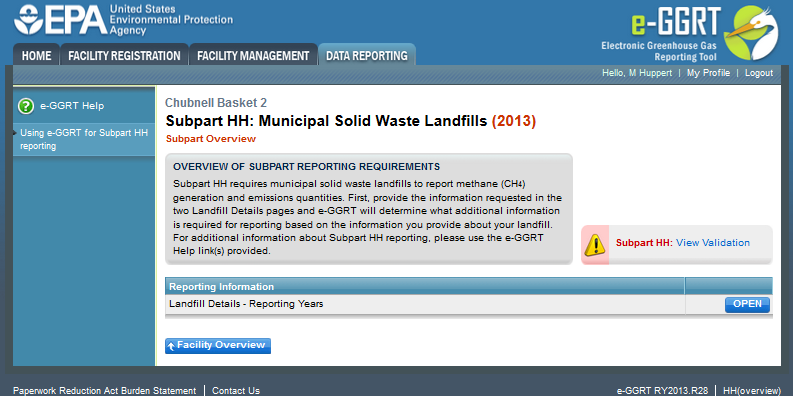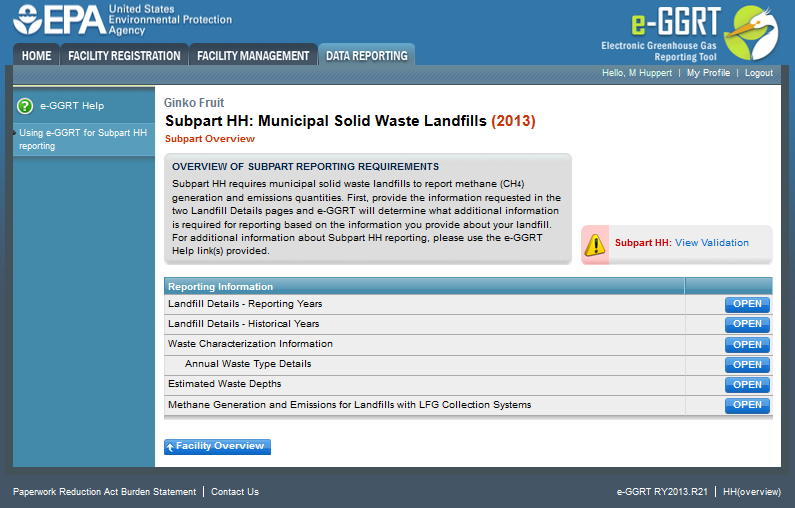Subpart HH applies to municipal solid waste (MSW) landfills that accepted waste on or after January 1, 1980.
This page provides an overview of sub-topics that are central to Subpart HH reporting:
- Subpart HH Landfill Details
- Subpart HH Waste Characterization Information
- Subpart HH Emissions Information
- Subpart Validation Report
- Carry forward of data from previous subpart HH submissions into current year forms
The end of this page contains links you can use for more information on these topics.
If you reported in the prior reporting year, most historical data will be prepopulated in your current report. See the Carry forward of data from previous submissions for details.
If this is is the first time you have reported under Subpart HH you will be presented with the following initial screen:
Click this link to expand
If you have previously reported Subpart HH or have already entered your landfill details you will initially see a screen with a number options and reporting components available as shown in the screen below. This screen, the Subpart HH Overview screen, is your portal to each of the individual Subpart HH reporting modules.
Click this link to expand
Landfill Details
The following MSW landfill information is collected for Subpart HH on the Landfill Details - Reporting Years page The reporter is then shown the first year of emissions reporting that occurred under Part 98 for the facility (i.e., 2010, 2011, 2012 or 2013). If the landfill was open during any reporting years, the method(s) used to determine the quantity of waste received at the landfill during the reporting year(s) must be indicated for loads other than cars, light duty trucks, and loads that cannot be measured with scales due to physical or operational limitations. Choose from one of the following methods (from §98.343(a)(3)) by checking the appropriate box: Note that the "Other" method was only available for the 2010 reporting year and only for facilities that were approved by EPA to use Best Available Monitoring Methods (BAMM). Per §98.343(a)(3), beginning in the first emissions reporting year, and each year thereafter, waste quantities must be determined using one of the methods listed above. If scales are in place at the landfill, they must be used to determine waste quantities for the first emissions reporting year and each year after. Additionally, the total annual waste disposal quantity(ies) in metric tons must be reported for each year and method. If you reported or resubmitted prior to the current reporting year, the methods and waste disposal quantity(ies) from prior years will be automatically populated and you will only need to enter data for the current reporting year. It is recommended that you review all automatically populated data to ensure its continued accuracy.Waste Disposal Quantities and Methods Since the First year of Reporting
Waste Disposal Quantities and Methods Prior to the First Year of Reporting
If you reported or resubmitted prior to the current reporting year, all of the waste disposal quantities and methods information will be automatically populated in your current year’s report and you will only need to review the information for correctness and completeness. For more on the historical migration of data, see Carry forward of data from previous submissions.
If this is your first year of reporting, you will need to indicate the methods used to determine the annual waste disposal quantities in the current year and all prior years. You will also need to report the annual waste disposal quantities for each year. Similar to the requirements since the first year of emissions reporting, the annual waste disposal quantities must be reported separately if scales and working capacity were used. Annual waste disposal quantities determined using all other methods are reported together.
Please go to Subpart HH Landfill Details for more details
Waste Characterization Information
If you reported or resubmitted prior to the current year, the waste characterization information for each year prior to the current reporting year should be automatically populated and you will only need to enter new data for the current reporting year based on the instructions below. However, you should review the data that appears for all years to ensure its accuracy. For more on the historical migration of data, see Carry forward of data from previous submissions. For each year that waste was disposed in your landfill, you will be prompted to enter the following information:
Additional information about the waste disposed at the facility is also collected in this section. Please go to Subpart HH Waste Characterization Information for more details.
Emissions Information
Landfills that do not have a landfill gas collection system are required to report annual CH4 emissions and CH4 generation (i.e., the modeled methane generation, calculated using Equation HH-1 of this subpart, and the CH4 generation, adjusted for oxidation, calculated using Equation HH-5 of this subpart), reported in metric tons of CH4.
Landfills that have a landfill gas collection system are required to report modeled and measured CH4 generation and CH4 emissions values (i.e., Equations HH-4, HH-5, HH-6, HH-7, and HH-8).
You will be allowed to elect to use either the rounded result of Equation HH-6 (as calculated and rounded by e-GGRT, unless entered by the user) or the rounded result of Equation HH-8 (as calculated and rounded by e-GGRT, unless entered by the user) to roll up into your total CO{~}2~e emissions from facility subparts as required by 98.3(c)(4)(i). If you make no election, e-GGRT will use the larger of the two rounded values. To override the Subpart HH emissions totals:
- Go to the Facility Overview page (click on the blue box at the bottom left corner of the Subpart Overview page)
- Click on “VIEW GHG DETAILS” at the bottom of the blue box with the calculators on the upper right side of the page
- Click “Edit result(s)” under the table titled “GHGDETAILS (source categories subparts C-HH)”
- Choose the row for Subpart HH CH4 and enter the value of the more accurate equation result in the “Own Result” box. You may only use either the result of Equation HH-6 or Equation HH-8 in this value. You may not use a value other than one of these two equation results as your Subpart HH emission total.
- Click “SAVE” at the bottom of the page
Please go to Subpart HH Emissions Information for more details.
Validation Report
The Validation Report assists you with determining the completeness and quality of your reported data. We strongly encourage you to use the Validation Report to check your work. The Validation Report performs two types of checks: Certain validation checks which are considered to represent critical errors must be corrected before you can successfully generate and submit your Annual Report. These checks are signified with a stop sign . If you feel that you have triggered one of these critical “stop signs” checks in error, or if there’s a reason why your report should be submitted despite the check being triggered, please submit a request to the e-GGRT Help Desk at GHGReporting@epa.gov. You may view the Validation Report at any time. Note that the Validation Report is intended to assist users in entering data, but it is not an indication that the reporter has entered all necessary information, nor is it an indication that the reporter is in compliance with part 98. Furthermore, a negative finding on the validation report is not a guarantee that a data element was entered incorrectly. For more detail on the Validation Report and its functionality please review the Subpart Validation Report page.
Carry Forward of Data from Previous Subpart HH Submissions into Current Year Forms
Please go to Carry forward of data from previous submissions for more details.
See Also
Screen Errors
Subpart HH Landfill Details
Subpart HH Waste Characterization Information
Subpart HH Emissions Information
Subpart Validation Report




